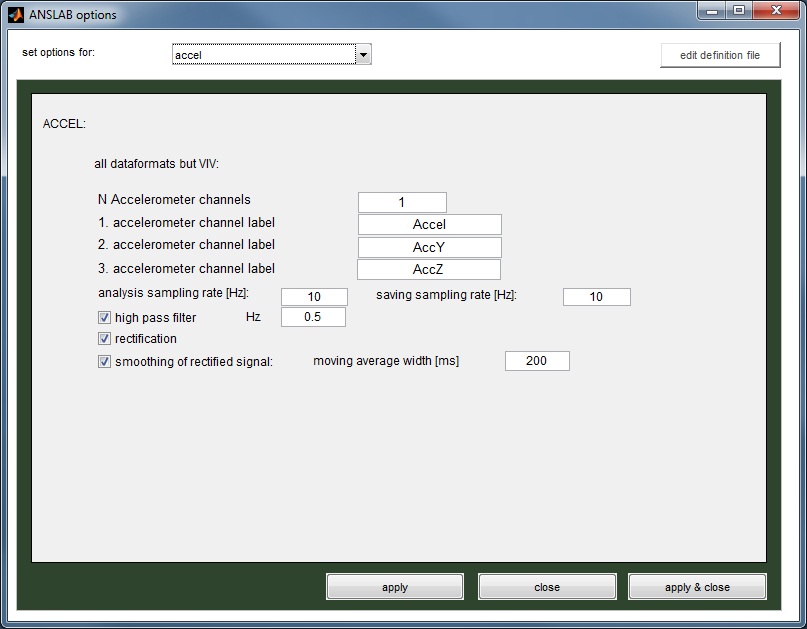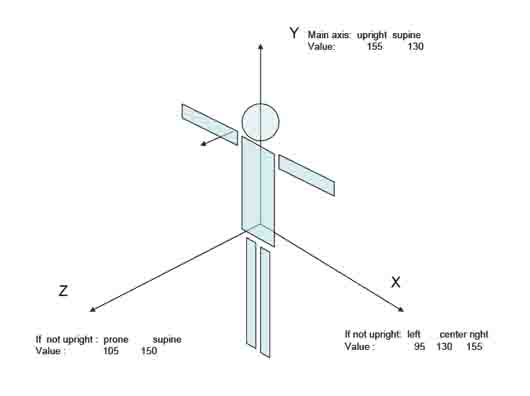What does this channel measure?
This channel measures the subject’s overall somatic muscular activity. It is used primarily to identify movement artifacts that influence other
data. ANSLAB decomposes the accelerometry signal into the fast moving AC component (red, corresponding to motoric activity
level) and the slow moving DC component (dark green, corresponding to changes in the angle of the sensor indicating tilt of the chair or
posture shifts).
Similar to the temperature editing, only edit and set to missing values if the sensor seems to have malfunctioned (e.g., zero line).

[
Top]
What qualities must be preserved in editing?
This channel rarely requires editing. The goal of editing this channel is to identify technical errors and exclude poorly
collected data from analysis.
On the 'accel' options tab you can adjust smoothing strength (width of moving average), high pass filter cut-off frequency and the default
channel label for batch processing.

[
Top]
VIV-file format
In case you are using the Vivologic data files, more options, such as posture- and activity/rest-analysis are available.
The Vivologic lifeshirt system uses standardized accelerometer sensors, allowing not only to generally extract the amount of motion of
a person, but also deriving his or her posture. The axes of the accelerometer are defined as depicted below:

If analysis of posture is activitated in the ANSLAB accelerometer options, ANSLAB extracts the posture component of each accelerometer
channel and recodes these signals to a 6-value posture index (ACCp); corresponding supine (1), prone (2), lying on left side
(3), lying on right side (4), upright sitting (5) and upright standing (6). Note that the sitting-standing differentiation is based on the
integrated motion component, assuming that upright position with no motion component corresponds to a sitting posture (thus static standing
will be mis-identified as sitting!). This index is plotted along with the raw posture components of the accelerometer channels as 'event'-type variables as shown below:

Identification of activity/rest-periods
ANSLAB offers the possibility to scan the activity motion component for periods within user defined threshold values in order to
parametrically identify periods of certain levels of activity or rest.
You can activate and configure this type of analysis on the second accelerometer options tab 'accel (VIV)':

The shown settings will cause ANSLAB to search for intervals of continuous activity of minimum 30 seconds length, ignoring preceeded
and following properties. To qualify, 90% of the values of the smoothed accelerometer motion signal (a moving average across 8 seconds)
have to be within the criterion range, which is 2 to infinity if only ACCX and ACCY are found in the file, and 3 to infinity if ACCX, ACCY and ACCZ is found.
No peak interval analysis is activated.
If you wish to identify multiple intervals with the given parameters, activate the 'load thresholds from
file'-option, set up a threshold definition file as shown below, and select it by using the browse-button.
The threshold definition file must be a tab-delimited textfile with 21 columns and 1 header row. An example for such
a definition file, which may be used as a starting point, is located at '\anslabutil\anslabdefault\AccThresholds.txt' inside your ANSLAB program folder.
It contains the defintions for a scan of 6 different levels of activity, no minimum duration and no preceding or subsequent required properties.
[
Top]




